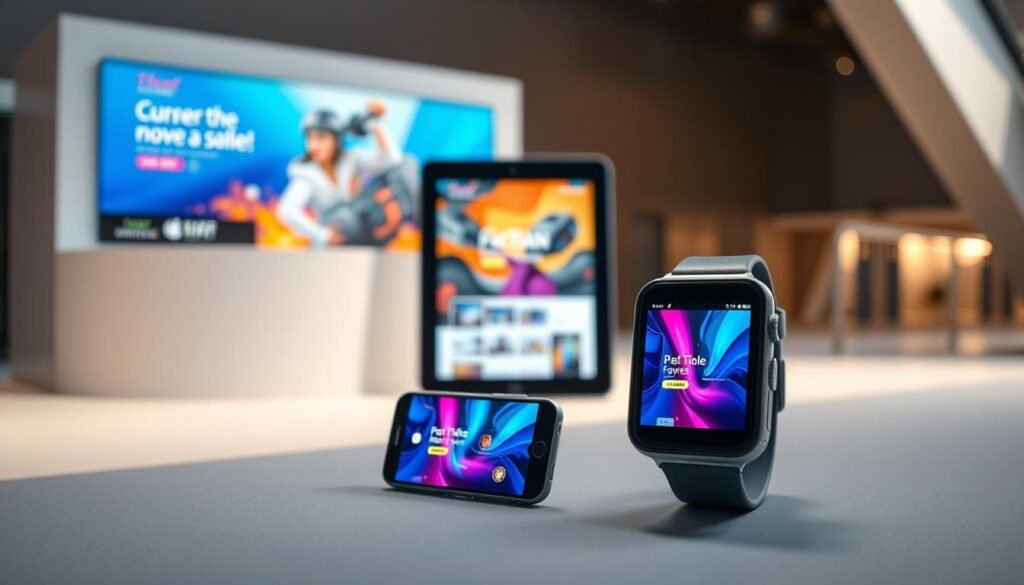In today’s digital world, mobile devices have become an integral part of daily life. People spend about 4 hours and 40 minutes on their mobile devices daily. This makes mobile a critical platform for businesses to connect with their audience.
As people increasingly use their devices for information, entertainment, and shopping, effective mobile marketing strategies are vital. This article will offer a detailed guide on mastering mobile marketing. It will cover optimizing ads for mobile devices and using the latest trends in mobile advertising.
Key Takeaways
- Understanding the importance of mobile marketing in today’s digital landscape
- Learning how to optimize your advertising strategies for mobile devices
- Discovering the latest trends and best practices in mobile advertising
- Mastering techniques to boost your business through effective mobile marketing
- Enhancing your overall digital marketing strategy with a focus on mobile
The Current State of Mobile Marketing
Mobile marketing has become essential for businesses today, with most internet users accessing the web via mobile devices. This shift has dramatically altered how businesses approach their marketing strategies. They now focus more on mobile-first consumer behavior.
The Shift to Mobile-First Consumer Behavior
Consumer interaction with businesses has undergone a significant transformation. With most internet users now accessing the web through mobile devices, companies must adapt to this new reality.
Key Mobile Usage Statistics in 2023
- Over 70% of digital media time is spent on mobile devices.
- Mobile commerce sales account for more than 40% of total e-commerce sales.
- The average user spends over 3 hours daily on their mobile device.
How Businesses Are Capitalizing on Mobile Trends
Businesses are using mobile marketing techniques like sms marketing and geofencing to effectively reach their target audience. By understanding mobile usage patterns, companies can craft targeted campaigns that connect with their customers.
By embracing mobile marketing, businesses can stay competitive and leverage the growing trend of mobile-first consumer behavior.
Defining Your Mobile Marketing Strategy
Mobile devices now dominate how we interact with the world. Crafting a solid mobile marketing strategy is more critical than ever. It allows businesses to engage with their audience more effectively, fostering meaningful interactions.
Step 1: Identify Your Mobile Audience
Grasping who your mobile audience is is fundamental to a successful strategy. You must analyze demographics, behaviors, and preferences. This will paint a detailed picture of your target audience.
Creating Mobile User Personas
Creating detailed user personas is key to customizing your marketing. These personas should outline age, location, device usage, and content preferences. This ensures your marketing meets the specific needs of your audience.
Step 2: Set Clear Mobile Marketing Goals
Establishing clear, measurable goals is vital for assessing your mobile marketing’s success. These goals must align with your business objectives. They could include boosting app downloads, increasing in-store visits, or improving customer engagement.
Step 3: Choose the Right Mobile Channels
Selecting the right mobile channels is critical. You need to choose those that best reach your audience. This might involve SMS marketing, mobile apps, or optimizing your website and emails for mobile.
| Step | Description | Key Considerations |
|---|---|---|
| 1. Identify Mobile Audience | Analyze demographics, behaviors, and preferences | Age, location, device usage |
| 2. Set Clear Goals | Align goals with business objectives | Increasing app downloads, boosting in-store visits |
| 3. Choose Mobile Channels | Select channels that reach your target audience | SMS, mobile apps, mobile-optimized websites |
By adhering to these steps and regularly reviewing and refining your strategy, you can ensure your mobile marketing is effective. It will align with your business objectives.
Essential Mobile Marketing Techniques
In the world of mobile marketing, several key techniques have become essential for businesses aiming to connect with their audience. These methods are crafted to be highly effective in engaging customers through their mobile devices.
SMS and MMS Marketing Implementation
SMS marketing is a potent tool for directly reaching customers on their mobiles. It boasts high open rates and is perfect for delivering urgent information. This makes SMS campaigns a standout choice.
Crafting Effective Mobile Messages
To make the most of SMS marketing, businesses need to create messages that are brief, clear, and engaging. Personalization plays a significant role, as messages tailored to the individual tend to resonate more.
Employing a conversational tone can also boost engagement. It makes the message feel more like a personal note than a marketing effort.
Timing and Frequency Best Practices
The timing and frequency of SMS messages are critical to their success. Sending messages at optimal times, like during lunch or early evenings, can significantly boost their visibility and response rates.
- Limit the frequency of messages to avoid overwhelming recipients.
- Consider the timing of messages in relation to the recipient’s time zone.
- Use data and analytics to refine your messaging schedule.
Mobile App Marketing Strategies
For businesses with mobile apps, strategies focused on app engagement and retention are critical. Techniques like push notifications, in-app messaging, and rewards programs can greatly improve user experience and encourage continued app use.
Mobile-Optimized Email Campaigns
While SMS marketing is effective, mobile-optimized email campaigns are also vital for a complete mobile marketing strategy. It’s essential to ensure emails are easy to read and navigate on smaller screens.
Utilizing responsive design and concise content can significantly enhance the impact of mobile email campaigns.
Optimizing Your Website for Mobile Success
In today’s digital world, having a mobile-optimized website is essential for businesses to remain competitive. Most online searches are now done on mobile devices. A mobile-friendly website is key for a good user experience and better search engine rankings.
Mobile-First Design Principles
Adopting mobile-first design principles means designing for the smallest screen first. Then, you move up to larger devices. This ensures your website’s core content and functionality work well on all devices. Important elements include:
- Simplified navigation
- Prominent calls-to-action
- Flexible grids and images
Improving Mobile Page Speed
Mobile page speed greatly impacts user experience and search engine rankings. A slow website can cause high bounce rates and lower conversion rates. To boost mobile page speed:
- Optimize images and compress files
- Minify CSS, JavaScript, and HTML
- Leverage browser caching
Technical Optimization Techniques
Technical optimization includes using Accelerated Mobile Pages (AMP) and optimizing server response times. AMP can greatly reduce page load times by removing unnecessary elements.
Mobile SEO Best Practices
Mobile SEO is critical for mobile visibility. This involves using responsive design, optimizing for voice search, and ensuring correct indexing by search engines.
Local SEO for Mobile Users
For businesses with a physical location, local SEO is vital. It means optimizing for location-based searches and ensuring accurate listings on directories and maps.

By applying these strategies, businesses can greatly enhance their mobile website performance. This improves both user experience and search engine rankings.
Location-Based Mobile Marketing
Location-based mobile marketing has become essential for businesses wanting to engage with their audience in real-time. It uses a user’s location to send targeted and personalized messages. This approach ensures that marketing efforts are not just seen but also relevant to the recipient.
Implementing Geofencing Campaigns
Geofencing empowers businesses to set up virtual fences around specific areas. When someone enters or leaves these zones, it can prompt a marketing action. This could be a push notification or SMS, tailored to the user’s location.
Setting Up Your First Geofence
To establish a geofence, businesses must:
- Identify the target location
- Define the radius of the geofence
- Determine the action to be triggered
- Monitor and adjust the campaign as needed
Beacon Technology for Retail Environments
Beacon technology uses small devices to communicate with smartphones. In retail settings, beacons can send personalized offers or information. This is done as customers move through the store, making their shopping experience more engaging.
Proximity Marketing Opportunities
Proximity marketing, powered by geofencing and beacons, opens up new avenues for businesses. It allows for timely and relevant messages, boosting customer engagement and sales. This strategy is key to creating a more personal and effective marketing experience.
In summary, location-based mobile marketing, including geofencing and beacon technology, equips businesses with the means to connect with their audience more effectively. It’s a powerful tool for driving engagement and sales.
Mobile Advertising Platforms and Formats
In today’s mobile-centric world, advertisers must understand various mobile advertising platforms and formats. This knowledge is key to maximizing campaign reach and impact. Mobile advertising has grown significantly, providing numerous options for businesses to engage with their audience.
In-App Advertising Strategies
In-app advertising is a powerful tool for reaching target audiences. By using popular apps, businesses can display ads that align with users’ interests and behaviors. In-app advertising enables precise targeting, boosting conversion rates.
Effective in-app advertising strategies include:
- Using contextual ads that match the app’s content
- Implementing rewarded video ads to enhance user engagement
- Utilizing native ads that blend seamlessly with the app’s UI
Mobile Display and Video Ad Creation
Mobile display and video ads are vital for a complete mobile advertising strategy. Mobile display ads come in various formats, such as banner ads, interstitials, and rich media ads. Mobile video ads offer a more engaging way to capture users’ attention.
Ad Format Specifications and Requirements
Understanding the specifications and requirements for different ad formats is essential. The following table outlines common ad formats and their specifications:
| Ad Format | Size | Description |
|---|---|---|
| Banner Ad | 320×50 | A standard banner ad displayed at the top or bottom of the screen |
| Interstitial Ad | Full-screen | A full-screen ad displayed between content or during natural transition points |
| Rewarded Video Ad | Varies | A video ad that rewards users with in-app currency or items upon completion |

Mobile Search Ads Optimization
Optimizing mobile search ads is critical for businesses aiming to increase visibility on search engines. This involves using mobile-friendly ad copy and ensuring landing pages are optimized for mobile devices.
Key strategies for optimizing mobile search ads include:
- Using location-based targeting to reach local customers
- Implementing ad extensions to provide additional information
- Utilizing call-only ads to drive conversions
Social Media Mobile Ad Campaigns
Social media platforms offer a range of mobile ad formats for reaching target audiences. By creating social media mobile ad campaigns, businesses can boost brand awareness, drive website traffic, and generate leads.
Effective social media mobile ad campaigns involve:
- Targeting specific demographics and interests
- Using visually appealing ad creative
- Monitoring and optimizing ad performance regularly
Measuring Your Mobile Marketing ROI
Understanding the ROI of your mobile marketing campaigns is essential for making smart investment decisions. To do this, tracking key performance indicators (KPIs) is vital. These KPIs should reflect the success of your mobile marketing strategies.
Essential Mobile Marketing Metrics
Identifying the right metrics is critical for evaluating your mobile marketing efforts. Metrics fall into two main categories: engagement and conversion metrics.
Engagement vs. Conversion Metrics
Engagement metrics measure user interaction, such as app downloads and time spent on the app. In contrast, conversion metrics focus on user actions, like making a purchase or signing up for a service.
Mobile Analytics Tools and Implementation
Businesses rely on mobile analytics tools to track these metrics effectively. Tools like Google Analytics for Mobile, Flurry Analytics, and Mixpanel offer insights into user behavior. This helps optimize your mobile marketing campaigns.
A/B Testing Mobile Marketing Elements
A/B testing is a powerful method for boosting mobile marketing performance. It compares two versions of a marketing element to determine which one performs better.
What to Test and How to Interpret Results
Elements to test include email subject lines and call-to-action buttons. When analyzing results, look for significant performance differences. This data guides you in refining your mobile marketing strategy.
| Metric Type | Description | Example |
|---|---|---|
| Engagement Metrics | Measures user interaction | App Downloads: 10,000 |
| Conversion Metrics | Tracks specific user actions | Sales: 2,000 |
| A/B Testing Metrics | Compares performance of different versions | Email Open Rates: Version A 20%, Version B 25% |
Overcoming Common Mobile Marketing Challenges
To succeed in mobile marketing, businesses must tackle a variety of hurdles. These include adhering to privacy laws and delivering ads effectively. Mobile marketing challenges can greatly affect campaign success. It’s essential to tackle these issues head-on.
Navigating Privacy Regulations
Complying with privacy laws is a major challenge in mobile marketing. Laws like GDPR and CCPA require businesses to handle consumer data with care.
GDPR and CCPA Compliance for Mobile
To meet GDPR and CCPA standards, businesses need to implement strong data protection. This includes:
- Transparent data collection practices
- Secure data storage solutions
- Easy opt-out mechanisms for consumers
By focusing on compliance, businesses can earn consumer trust and avoid significant fines.
Addressing Cross-Device Tracking Issues
Cross-device tracking is a significant challenge for mobile marketers. Consumers often use multiple devices, making tracking complex.
To overcome this, marketers can use:
- Unified tracking platforms
- Deterministic and probabilistic matching techniques
These methods help create a cohesive user experience and offer a clearer view of consumer behavior.
Strategies to Combat Mobile Ad Blocking
Mobile ad blocking is a major problem, with many users blocking ads. To counter this, marketers can:
- Offer ad-supported versions of their apps or services
- Implement non-intrusive ad formats
- Educate users about the importance of ads in supporting free content
By employing these tactics, businesses can lessen the impact of ad blocking on their campaigns.

Conclusion
Throughout this article, we’ve seen the importance of mastering mobile marketing for business success. The rise of mobile-first consumer behavior has reshaped marketing strategies. It’s now vital to have a solid mobile marketing plan.
“The future of marketing is mobile.” This statement emphasizes the need to adapt to the mobile landscape. Understanding your mobile audience, setting clear goals, and selecting the right channels are key. This way, you can craft mobile marketing campaigns that yield results.
The article’s key points stress the need for a mobile-optimized approach. This includes optimizing websites, email campaigns, and ad strategies. By adopting these strategies and overcoming common hurdles, businesses can enhance their mobile marketing ROI. This keeps them competitive.
In summary, mobile marketing is now a cornerstone of business growth, not just an add-on. By focusing on mobile marketing and staying updated with trends and technologies, businesses can thrive in our increasingly mobile world.
Sources
For further information on mobile marketing strategies and industry trends, refer to the following credible sources:
- Mobify – Mobile Marketing Strategies
- Smart Insights – Mobile Marketing Strategy
- Marketing Profs – Mobile Marketing Articles
- Leanplum – Mobile Marketing Trends
These mobile marketing sources offer valuable insights and data. They help businesses optimize their mobile marketing efforts.
FAQ
What is the importance of having a mobile marketing strategy?
A mobile marketing strategy is vital. It enables businesses to connect with their audience on mobile devices. This approach boosts conversions and revenue.
How can businesses capitalize on mobile trends?
To leverage mobile trends, businesses should focus on mobile-first strategies. They should use mobile-specific ads and optimize their sites and apps for mobile use.
What are the benefits of using SMS and MMS marketing?
SMS and MMS marketing boast high open rates and engagement. They allow for targeted, personalized messages. This makes them effective for reaching customers.
How can businesses optimize their website for mobile success?
For mobile success, businesses should adopt mobile-first design. They should also improve page speed and follow mobile SEO best practices. This ensures a smooth user experience.
What is geofencing and how can it be used in mobile marketing?
Geofencing targets customers in specific areas. It allows businesses to send messages and offers to those nearby. This technique is powerful for location-based marketing.
How can businesses measure the ROI of their mobile marketing efforts?
To gauge ROI, businesses should track key metrics and use analytics tools. A/B testing helps optimize campaigns. This improves performance and results.
What are some common challenges in mobile marketing and how can they be overcome?
Mobile marketing faces challenges like privacy regulations and ad blocking. These can be tackled by following best practices and using new technologies. Staying updated with industry trends is also key.
What is the role of in-app advertising in mobile marketing?
In-app advertising is critical in mobile marketing. It allows businesses to engage with users in apps. This drives conversions and revenue through various ad formats.
